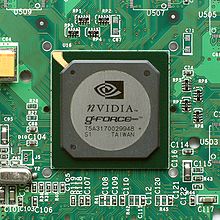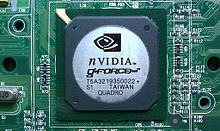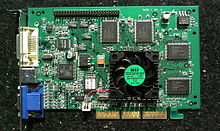- GeForce 256
-
Nvidia GeForce 256 
Codename(s) NV10 Release date 1999 Mid-range GPU GeForce 256 SDR High-end GPU GeForce 256 DDR Direct3D and shader version Direct3D 7.0, T&L The GeForce 256 is the original release in Nvidia's "GeForce" product-line. Released on August 31, 1999, the GeForce 256 improves on its predecessor (RIVA TNT2) by increasing the number of fixed pixel pipelines, offloading host geometry calculations to a hardware transform and lighting (T&L) engine, and adding hardware motion-compensation for MPEG-2 video. It offered a notably large leap in 3D gaming performance and was the first fully Direct3D 7-compliant 3D accelerator.
Contents
Architecture
Upon release, GeForce 256 offered industry-leading real-time 3D rendering performance. It was marketed as "the world's first 'GPU', or Graphics Processing Unit," a term Nvidia defined at the time as "a single-chip processor with integrated transform, lighting, triangle setup/clipping, and rendering engines that is capable of processing a minimum of 10 million polygons per second."
The integration of the transform and lighting hardware into the GPU itself set the GeForce 256 apart from older 3D accelerators that used separate chips for the task. This reduction of 3D graphics solution complexity brought the cost of such hardware to a new low and made it accessible to cheap consumer graphics cards instead of being limited to the previous expensive professionally-oriented niche designed for computer-aided design (CAD). NV10's T&L engine also allowed Nvidia to enter the CAD market for the first time, with a product called Quadro. The Quadro line uses the same silicon chips as the GeForce cards, but has different driver support and certifications tailored to the unique requirements of CAD applications.[1]
Performance and value
GeForce 256 offered exceptional 3D performance that surpassed existing graphics cards. Compared to previous high-end 3D game accelerators, such as 3dfx Voodoo3 3500 and Nvidia RIVA TNT2 Ultra, GeForce provided up to a 50% or greater improvement in frame rate in some game titles (ones specifically written to take advantage of the hardware T&L) when coupled with a very slow budget CPU.[2] Support of the full Direct3D 7 API also assured the card of a strong future, unlike its initial Direct3D 6 based competition. The GeForce 256 was supported in games up until approximately 2006, in games such as Star Wars: Empire at War.
However, without broad application support a the time, critics pointed out that the T&L technology had little real-world value. Initially, it was only somewhat beneficial in certain situations in a few OpenGL-based 3D first-person shooter titles, most notably Quake III Arena. Benchmarks using slow, budget CPUs like the Celeron 300A would give favourable results for the GeForce 256, but benchmarks done with faster CPUs such as the Pentium II 300 would give better results with some older graphics cards like the 3dfx Voodoo 2. 3dfx and other competing graphics card companies pointed out that a fast CPU could more than make up for the lack of a T&L unit. Software support for hardware T&L was not commonplace until several years after the release of the first Geforce. Early drivers were buggy and slow, while 3dfx cards enjoyed efficient, high speed, mature Glide API and/or MiniGL support for the majority of games. Only after the GeForce 256 was replaced by the GeForce 2, and ATI's T&L-equipped Radeon was also on the market, did hardware T&L become a widely-utilized feature in games.
The GeForce 256 was also quite expensive for the time and it didn't offer tangible advantages over competitors' products outside of 3D acceleration. For example, its GUI and video playback acceleration were not significantly better than that offered by competition or even older Nvidia products. Additionally, some GeForce cards were plagued with poor analog signal circuitry that caused display output to be blurry.[citation needed]
As CPUs became faster, the GeForce 256 showed that the disadvantage of hardware T&L is that if a CPU is fast enough, it can perform T&L functions faster than the GPU, thus making the GPU a limit to rendering performance. This changed the way the graphics market functioned, encouraging shorter graphics card lifetimes, and placing less emphasis on the CPU for gaming.
Specifications
Discontinued support
NVIDIA has ceased driver support for GeForce 256 series.
Final Drivers Include
- Windows 9x & Windows Me: 71.84 released on March 11, 2005; Download;
- Windows 2000 & 32-bit Windows XP: 71.89 released on April 14, 2005; Download.
Competitors
See also
- Graphics card
- Graphics processing unit
References
- ^ "Nvidia Workstation Products". Nvidia.com. http://www.nvidia.com/page/workstation.html. Retrieved 2007-10-02.
- ^ Ross, Alex and Wood, Joan (October 14, 1999). "Nvidia GeForce 256 DDR Guide". Sharky Extreme. pp. 6. http://www.sharkyextreme.com/hardware/guides/nvidia_geforce256/6.shtml. Retrieved 2008-06-14.
External links
- NVIDIA: GeForce 256 - The World's First GPU
- ForceWare 71.84 drivers, Final Windows 9x/ME driver release
- ForceWare 71.89 drivers, Final Windows XP driver release
Nvidia Graphics processing units Early chipsetsRIVA seriesGeForce 256 · GeForce 2 · GeForce 3 · GeForce 4 · GeForce 5 · GeForce 6 · GeForce 7 · GeForce 8 · GeForce 9 · GeForce 100 · GeForce 200 · GeForce 300 · GeForce 400 · GeForce 500Other seriesTechnologiesMotherboard chipsets GeForce SeriesnForce SeriesnForce 220/415/420 · nForce2 · nForce3 · nForce4 · nForce 500 · nForce 600 · nForce 700 · nForce 900TechnologiesOther products Project DenverBridge chipsHandheldSoftwareAcquisitionsKey people Jen-Hsun Huang · Chris Malachowsky · Curtis Priem · David Kirk · Debora Shoquist · Dr. Ranga Jayaraman · Jonah M. AlbenCategories:- 1999 introductions
- Nvidia
- Video cards
Wikimedia Foundation. 2010.



